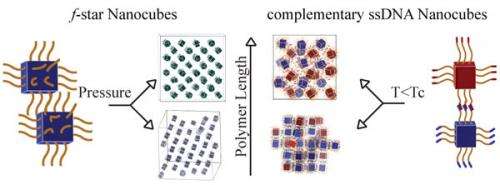Researchers show polymerized nanocubes form complex structures

(Phys.org) —Nanoparticles assembled in new ways hold the promise of a wave of new high-tech materials that could offer high strength, enhanced magnetic properties, light reflectivity or absorption, use as catalysts and much more. Scientists at the U.S. Department of Energy's Ames Laboratory have developed a theoretical model to explore the effect of polymer coatings, including DNA, for self-assembly of nanocubes into so-called superlattices.
What makes the work by Ames Laboratory physicist Alex Travesset and graduate assistant Chris Knorowski significant is that they have characterized how these nanocubes form crystalline and liquid crystalline structures. Their work was published in the Dec. 10 issue of the Journal of the American Chemical Society and mentioned in an Editor's Choice article in the January 31 issue of Science.
"Spherical nanoparticles, are isotropic so they can align in any direction," Travesset explains. "Nanocubes are different. They are anisotropic, so they display orientational order. They will only stack together if the faces orient in certain ways."
"From a more applied point of view, cubes can pack together more efficiently than spheres; in configurations that do not leave any gaps," he adds, "so they are of interest in areas such as catalysis where you want to maximize contact area."
To date scientists had only considered theoretical systems that consist of hard nanocubes. However, by coating nanocubes with strands of polymer, the structures that form are bound together so that they can be extracted and studied in laboratory environments. The nanocubes can be metallic, gold or silver, or made of semiconducting material.
Travesset's theoretical model uses both a general polymer and DNA. While both resulted in assembly of nanocubes into complex crystalline structures, the DNA system allows control of self-assembly by hybridization of complementary base pairs.
"With DNA, you can encode information about which cubes are going to assemble with which other cubes," Travesset said. "It gives you a more precise way to target relevant self-assembled structures."
"Because the system can be polymerized in water, the assembled structure can be extracted and used in dry environments," Travesset said. "And these complex structures provide much more opportunity for applications and systems than simple hard cubes allow. We hope these systems will lead to further experimentation."
Journal information: Science , Journal of the American Chemical Society
Provided by US Department of Energy





















